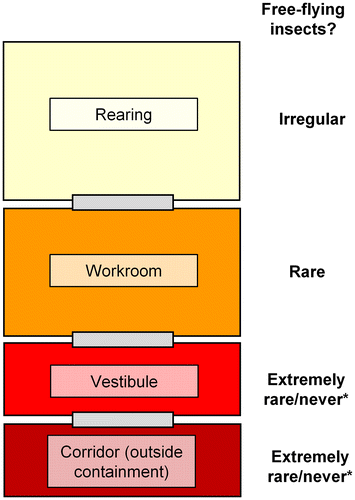Figures & data
Figure 1. Monitoring baseline levels of free-flying insects within the contained insectary. The number free-flying insects discovered in the containment facility should be monitored continuously and new SOPs or additional training provided as needed to keep baseline levels in rearing spaces as close to zero as possible.

Figure 2. Baseline level of escaped insects in an ACL-2 insectary. While the occasional free-flying insect will be discovered within the rearing space, such events should be progressively rarer across each barrier leading finally to the external corridor. *Note that in locations where the same or similar species occur locally, migration of wild insects from outside into the corridor, or from the corridor into the vestibule is possible. Operating procedures for such facilities must anticipate this possibility, and be sufficient to allow the unambiguous determination of changes in the frequency of insect releases.

Figure 3. An SOP to prevent accidental release of adult mosquitoes during small cage manipulation. (A) In high density cages, adult mosquitoes often rest on the interior walls of pupal containers. When the containers are removed, these adults fly away. To prevent this, all pupal containers should be covered with a snap-on lid before removing the container. Adults resting on interior walls will be trapped and devitalized by freezing. (B) Removal of cups/containers using secondary cages. Secondary cages will contain a stocking entrance on two opposite sides, allowing researchers to transfer containers from a main cage directly to the secondary cage. Escapees from the main cage will now be trapped in the secondary cage. With fewer adults present in the secondary cage, the egg cup can be more easily removed while preventing releases. The escapees can then be killed by freezing, or aspirated and returned to the main cage.


![Figure 4. Institutional challenges when gene drive research scales up. Management and oversight of gene drive research from an institutional perspective [green, light green, yellow, orange, red represent the progression of difficulty from easiest to hardest].](/cms/asset/71f2f6b7-8b48-4e83-ae73-334c91e817e3/ypgh_a_1424514_f0004_oc.gif)